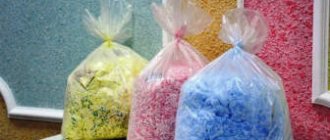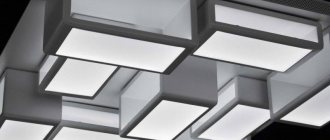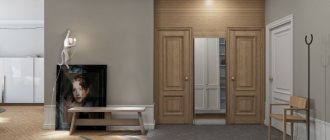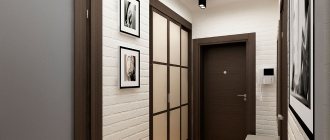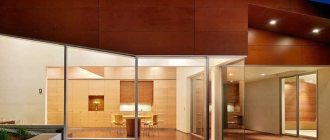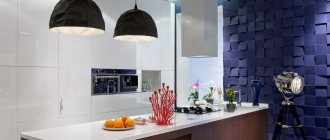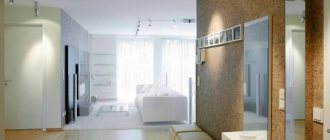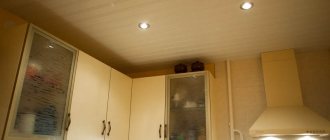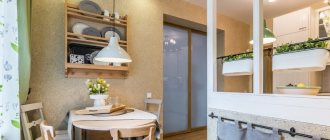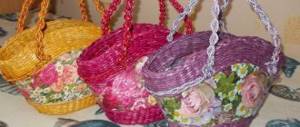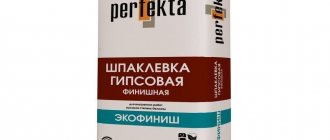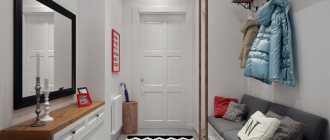Corridor wall panel
Wall slabs for the corridor are obtained from both artificial and natural raw materials. Due to its low cost and high performance qualities, this material is in great demand among consumers.
Wall panels with a pattern for the kitchen, what they look like and how they are used can be found here in this article.
In the building materials store, panels are presented in a wide range. The entire variety of products can be divided into the following types:
- Rack and pinion This material is characterized by the following dimensions: length - 2.5-6 m, width - 10-40 cm. They have a tongue-and-groove locking connection, there is no seam, and they have a relief texture. Installation of such products can be carried out in both horizontal and vertical positions.
- Tiled . The shape of such a product resembles ceramic tiles in the form of a rectangle or square. They can take different sizes, and are equipped with a tongue-and-groove locking connection. To decorate the walls, you can use one size or make a specific pattern using material of different dimensions, colors and textures.
- Leafy . These panels produce large dimensions. The main advantage of this material is that they are laid on a flat surface without lathing. For fastening, glue and mastic are used.
Leroy Merlin PVC panels are one of the best building materials in their class and price range, which you can learn about in more detail from the article.
The available options for wall panels allow you to create different interiors, bringing into reality both classic options and unusual finishes.
The video shows wall panels for the corridor:
Leroy Merlin wall panels are one of the best building materials about which you can read this article.
Material advantages
Wall slabs for the corridor are an excellent option for transforming the room. In addition to its low cost, this material also has excellent performance properties. The following advantages of wall panels are highlighted:
- Easy to install . Now you don’t need to spend extra money to call a specialist to your home.
- There is no need to carry out preparatory measures such as leveling or removing old materials from the surface before installation.
- To install the panels, you do not need to use special equipment or tools. All you need are wooden blocks, nails, panels. If the installation of the material is carried out without lathing, then you can get by with only one glue.
- This finish is very easy and simple to care for. It is necessary to wipe the surface with a damp cloth.
- This material allows you to achieve excellent sound and heat insulation characteristics.
- If there is a defect on one panel, you do not need to do all the work again. In this case, it is possible to replace only the damaged panel.
- Despite their low cost, corridor wall panels have a long service life.
- The material is hygienic, durable and resistant to mechanical influences.
Bathroom wall panels, price and other technical characteristics of the building material can be found out and photos in this article.
In the video - wall panels for the corridor under the stone:
Today, manufacturers try to satisfy all the wishes of their customers, therefore they produce high quality materials. Using wall panels in the corridor, it is possible to carry out cosmetic repairs quickly and inexpensively.
Types of panels
The following types of wall materials can be used to decorate the corridor:
- PVC panels;
- MDF panels;
- wooden lining;
- laminate;
- bowsery;
- structural 3D panels.
PVC panels
Plastic panels are one of the most common types of cladding. This is a moisture-resistant material that has a smooth surface, so it is easy to clean. Has good abrasion resistance.
MDF panels
Medium density fiberboard is used as a base. Depending on the quality and cost, they have different types of coverage. The most inexpensive samples have a paper coating with a pattern applied to it: this type of finish is leaving the market. MDF sheets with a laminated polymer coating are more relevant. This coating is more reliable and practical.
Both lining panels and large-format sheets are used. The lining elements have a standard length of 2.6 m, the width can vary from 10 to 40 cm. The edges of most modern MDF panels have locks, so they fit together securely and efficiently.
Wooden lining
Currently, it is used quite rarely due to its very high cost. In addition, modern MDF materials are often not inferior to it in quality and appearance.
Laminate
Laminate flooring can be used to decorate corridor walls. Recently, this method has become increasingly popular.
This is due to the reduction in cost of laminate production, as well as the fact that this material has a wide range of colors. In addition, the laminate coating has increased resistance to scratches, damage and abrasion.
Even the thinnest and most inexpensive class 31 laminate is suitable for such cladding, the cost of which is comparable to the cost of high-quality MDF or PVC lining. This finish will not have noticeable seams, the material looks like a single whole.
It is necessary to provide a method for attaching the laminate so that the fasteners are not noticeable. There may also be problems with the selection of additional elements - corners and end strips. The thickness of laminate flooring and some MDF panels is the same, so you can use the elements that come with them.
Bowsery
Bauzeri is an elite finish, which consists of wood panels with decorations in the form of carvings and inserts of other types of wood. Most often, such panels are coated with tinted varnish, sometimes in combination with enamel or gilding. Such cladding is expensive and must be performed by experienced craftsmen.
Interior decoration of the hallway
A variety of materials can be used in the manufacturing process of interior wall panels. The resulting product has its own unique characteristics.
PVC
This material is now produced in a wide range of shapes, shades and coatings. In addition, PVC panels have long been considered the most optimal finishing material in terms of price and quality. Such finishing has long been no longer considered cheap and unpretentious.
You can learn how to use plastic brick wall panels from this article.
The photo shows wall panels in the corridor:
The walls in the corridor can be covered with variegated or plain ones, with abstraction or imitation of natural stone. In addition, today it has become possible to decorate the walls of the corridor using panels with 3-D photo printing and mirror panels. Thanks to such a huge selection, you can turn your wildest dreams into reality. The disadvantages of PVC panels include fragility and instability to fire.
What are the dimensions of MDF panels for walls can be found in this article.
As for the advantages, there are a large number of them:
- Environmental friendliness . The presented material is today used in the industry for the production of food packaging or medical equipment. It immediately becomes clear that it is environmentally friendly.
- Resistance to moisture . Of course, when installing panels in a corridor, it cannot be said that there is high humidity, but, nevertheless, this criterion is very important. Since the surface is qualitatively protected from moisture, harmful microorganisms will not form on the walls. PVC panels can be used not only in the corridor, but also when finishing the kitchen or bathroom.
- Easy to install . All installation work can be carried out by a person without specific experience and knowledge. There is no need to carry out preparatory work or level the walls.
- Excellent decorative possibilities . There is a wide palette of colors, shapes and textures. There are products that already have a pattern on the surface. Everyone will be able to choose a material that would ideally match a specific interior.
How to use moisture-resistant wall panels for the kitchen can be found in this article.
MDF
Such material cannot be sold in a wide variety of shades and patterns. Most often they are produced to imitate wood and stone. On the surface of the panel there is thick paper, laminated or painted with a varnish composition. The most important advantages of such panels remain low cost, attractive appearance, environmental friendliness, and resistance to water and fire. But this advantage is achieved provided that the surface of the slab is treated with special impregnations.
Fiberboard
To obtain such a finishing material, veneer made from valuable wood species is used. Most often, such slabs imitate natural wood. Thanks to fibreboards, it is possible to finish the corridor in a classic style without using expensive materials.
laminated chipboard
This material is laminated particleboard, which is most often thicker than fiberboard and MDF. Thanks to this, you can not only cover the walls in the corridor, but also place pictures, photographs there, and install a mirror. This material has high strength, is not affected by moisture, can withstand strong impacts, is not susceptible to abrasion and can withstand various attacks from small children.
Tree
This material is considered the most expensive. Natural wood for panels is coated with opaque paints, varnishes or wax. Thanks to such decoration methods, it is possible to obtain a type of wood that will always delight you with its appearance.
To give the material depth and color, you should use tinting using stain or artificial aging. If you want a more budget-friendly option, then here you can pay attention to frame or veneered materials. Inexpensive wood species are used as the basis here.
Here you can read about stone-look MDF panels, as well as the features of their use.
The disadvantages of such panels include the possibility of cracks forming on the surface, swelling, and instability to water and fire. In addition, the appearance of the decoration in the corridor will have to be maintained from time to time. To do this, it is worth using varnishing and waxing.
Decorative cork
Although this option is not the most budget-friendly when decorating walls in the corridor, the available performance characteristics justify everything. Such products are characterized by their lightness, durability, and decorativeness. This material can be used to decorate a hallway; it combines perfectly with any type of interior.
Leather, textiles, glass and other exotics
Many designers use a wide variety of materials in the manufacture of wall panels:
- glass;
- metal;
- natural stone plates;
- Corian panels;
- fur;
- felt;
- leather or leatherette.
However, there are panels for exterior decoration of the house, which you can learn about in more detail by reading this article.
All presented materials allow you to turn the corridor into a real work of art.
Materials, their pros and cons
Each of the materials that can be used to decorate the corridor has its own disadvantages and advantages - this is a fact.
Plastic panels
Plastic panels for the corridor - a high-quality, viable solution
PVC panels for the hallway (products made of polyvinyl chloride) are a material that is one hundred percent artificial. However, it does not contain cadmium or asbestos - and this is very good from an environmental point of view.
In addition, plastic panels have a cellular structure - this has a very beneficial effect on sound insulation (this is also very important today).
What else can you say about this finishing material? Much:
- The range of designs and colors is quite large. Due to this, you will be able to bring a variety of ideas to life. The photos of the corridor finishing with panels speak for themselves - look at them once and you will understand everything yourself.
- Here is the photo code
- Protective coating available. Thanks to this, the material has impressive resistance to sunlight and UV radiation;
- Finishing a room with panels can be done even where the humidity level is high;
- The surface is easy to keep clean - the panels are very easy to clean and are hygienic;
- It is not recommended to use such material inside residential spaces: this is due to its artificial origin (but PVC panels are ideal for a corridor - that’s a fact).
MDF wall panels for finishing corridors
MDF panels - excellent imitation of natural wood
How are MDF panels made today? For production, wood dust is used, to the composition of which fine shavings are also added. Under great pressure, all this is compressed when exposed to high temperatures.
More information about MDF panels:
- On average, the thickness of such panels is 15 mm - they look very similar to wood;
- Cutting MDF is very simple: they do not crumble or break;
- In a room, such material (if the walls are decorated with it) significantly increases thermal insulation and sound insulation;
- Today on sale you can easily find panels with high moisture resistance. The presence of moisture-resistant impregnation will be indicated by the image of a drop of water (you will need to carefully inspect the packaging);
- Panels are also produced with fire-resistant impregnation - today such properties are highly valued;
- You can use these panels in any room of your apartment. But they will look best in the hallway (or corridor).
Natural wood panels for finishing the corridor
The most expensive option possible: panels made from natural wood
For the production of panels, the most expensive material can be called wood - any hard species. A similar solution in terms of cost can be called wood, which is finished with veneer made from natural wood. People who like to save money prefer to use plastic panels for walls.
What types of trees are used to produce wood trim panels?
There are plenty of options:
- Beech and oak;
- Ash and alder;
- Pine and maple.
In order for such a material (wall panels made of natural wood) to be resistant to fire and moisture, the finished panels must be impregnated with various specialized compounds - otherwise this is not done in our time.
More details about the finishing material:
- If we consider veneered panels, the main layer is made of pine - such wood is considered the cheapest. Veneer is glued to it in two or three layers. The front layer is glued from veneer, which is made from any valuable wood species;
- All these layers are fastened together - for this, hot pressing technology is used;
- Then the panels are usually polished, varnish, paint or wax are applied to them;
- People who are ready to invest a significant amount of money in decorating their corridor can purchase custom-made panels that are made entirely from valuable and hard wood (the material is one hundred percent free from impurities), and then carefully polished.
When entering a house or apartment, panels made from natural wood look very impressive and noble - this is an indisputable fact.
Fiberboard panels for finishing the corridor
In the decoration of the corridor, fiberboard panels are not so rare
Fibreboard (also known as fibreboard) is made from wood fibers by hot pressing. Under the influence of pressure and high temperatures, lignin is released from wood fibers.
This substance is an organic binder. So, when fiberboard is made, no synthetic binders are used - and this, from an environmental point of view, is very good.
However, other fibers of plant origin can also be used to produce fiberboard.
What are the benefits of fiberboard panels for finishing a corridor? Let's figure it out:
- These panels, made of wood fiber boards, are environmentally friendly and are absolutely harmless to human health or pets. You can safely use them in cladding your living space. These panels are very easy to clean and are not afraid of moisture;
- Finishing a corridor with fiberboard panels (or a hallway) is a common phenomenon. Many choose this particular material because the result is more than worthy.
Prices
The cost of wall panels largely depends on the type of processing and the material used. For each type of panel it is different:
- laminated – 290 rubles;
- PVC – 235 rubles;
- MDF -150 rubles.
How to use such a material as a glass wall panel for the kitchen can be found in this article.
Wall panels for finishing the corridor can be presented in various variations. Here you can change the color, texture, shape of the panels. But at the same time, it is necessary to understand that the main selection criteria remain such material features as strength, sound and heat insulation, and fire resistance.
Corridor made of MDF panels: photos and results
Practical finishing material, attractive appearance, all this can be said about MDF panels. Like laminate, its use is popular.
MDF panels provide a long service life and guarantee that they are resistant to external factors and have high strength. All this thanks to the production of pressed wood and high-temperature processing. Due to its strength, MDF is often compared to lining.
When decorating a hallway, MDF panels will help hide all imperfections without first leveling the walls
MDF panels are resistant to moisture and do not deteriorate from chemicals used during cleaning.
An integral positive side of MDF panels is considered to be their practicality. Their installation is simple and will be easy for even the most inexperienced repairman.
Adherents of environmentally friendly materials can also choose MDF panels, since they are made exclusively from environmentally friendly materials and provide good sound insulation.
Main types of panels for wall cladding
In the corridor, as a rule, no increased requirements for moisture resistance, sound and heat insulation are imposed on the finishing; the main attention when choosing it is paid to operational and aesthetic qualities.
Depending on the interior concept, one of the types of panels can be selected:
- Tiled type, which looks very similar to tiles, but has a fundamental difference in the fastening system. The panels are mounted using a tongue-and-groove system. They are usually used to decorate only part of the room.
- Rack type, very reminiscent of traditional lining in shape and fastened using a tongue-and-groove system. The maximum width of the elements is 40 cm, standard length is 6 m (some models 2.5 m).
- Sheet type, which is optimal for non-standard premises. The dimensions of the elements are from 1.22 m to 2.44 m. This is a multilayer material with a maximum thickness of 6 mm, which can imitate tiles, stone, and wood.
Stone effect wall panels
In addition to the listed types, extraordinary forms of elements are also produced. Any configuration can be made to order.
